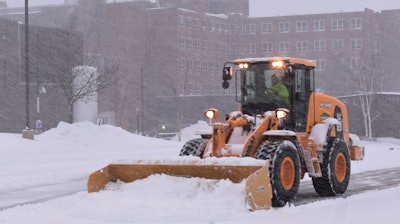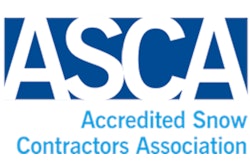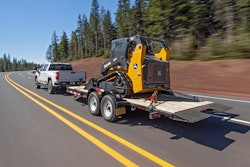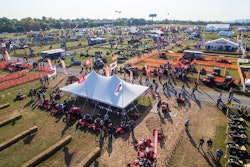
This has been a year like no other. It represents the perfect storm of problems hitting the customer base of so many snow contractors.
Leaders of the two largest snow contractor associations, Martin Tirado, executive director of Snow & Ice Management Association (SIMA) and Kevin Gilbride, executive director of the Accredited Snow Contractors Association (ASCA) agree that the 2020 winter will be tumultuous for contractors for a variety of reasons.
On the macro level, the COVID-19 pandemic is expected to have a significant impact. The overall economic impact on property and facility management will likely lead to budgets being lowered. In addition, retail sites and other facilities are going to close permanently or be slow to reopen and COVID-19 has forced many into the new reality and accepted method of working from home. There are also going to be several new cleanliness and sanitation policies that everyone working on a property need to be aware of and comply with.
Looking at long term weather forecasting, the winter of 2020-21 appears to be headed for a rebound. The winter of 2019-20 had low snow and ice accumulation in several parts of North America. After lower snow years, the averages historically ‘catch-up’ and produce average to above average snowfall in areas that were low the previous year.
“You can't control whether it snows or not,” ASCA Executive Director Kevin Gilbride said. “What you can control is your communication with your clients and that's what you’ve got to focus on.”
Weathering a Virus
Going into the 2020 winter, snow removal contractors are coming off one or two lower than average snowfall years.
“I don't think you can talk about the COVID issue without talking about the light winter that we had last year,” Gilbride said. “I think there's going to be a dual effect this year.”
He noted that customers with seasonal contracts are likely looking at that and saying, “we paid for a whole bunch of stuff that we never got.” Conversely, contractors that were operating on largely seasonal contracts in areas where there was little snow did very well because of the lower expenses.
The challenge becomes maintaining those customers on those seasonal contracts after a low snow winter.
“It seems to be whenever you have one of these ridiculously low winters, these people decide I'm not going seasonal and I'm going to go per push and then they end up getting whacked the next year,” Gilbride said.
The ASCA director says the best way to go for property owners is to decide the style of contract and then maintain that annually.
“If you go per push, stay per push, because in a low year, you’re not going to pay and in a high year you’re going to pay a lot,” he said. “If you want to manage your budget, and you want to stay consistent, go seasonal, because you're going to have a year where you go real low and you're going to pay for stuff that is not going to happen but then you're going to have another year with 60-inches of snow but you are paying the same rate.”
Contractors need to best manager their business by having a mix of both, so the proportion of seasonal and per push offset each other depending on the snowfall each year.
With the lower snow totals from the 2019-20 winter that customers are already thinking about, then you add in the COVID-19 pandemic.
“Hopefully, there is a light at the end the tunnel and we have a good snow and ice year and that's going to just necessitate services be performed,” Tirado said.
For the contractors, it depends on your base of business. “If your base of business happened to be customers that were deemed essential manufacturing plants during the COVID-19 shutdown, then you're probably going to be okay, because they made money throughout,” Gilbride said. “However, if your base of business was shut down during that time, you're probably going to have a challenge.”
Those with retail accounts as primary clients may be facing even more of a challenge. “We have no idea what's going on with the retail sector because while it's back in many states, it's certainly not being frequented as often as it used to,” Gilbride said. “So, what are retail plazas going to look like?”
Tirado agreed, citing JC Penny’s closure of numerous stores as an example of how difficult it may become. Some retail stores may not be able to survive the pandemic and in general occupancy in some of the retail plazas may decline.
“You've got to keep the lots open in case there is some type of safety accessibility but it would be pretty bare bones service,” he said, noting that operators need only plow the main route in front of a facility and that's it. For closed facilities, there isn't that much to do, and it is also not necessarily as timely compared to an open retail space.
On the other hand, Tirado sees opportunity in the shipping and receiving world. He noted the large warehouse facilities where essential products and goods for grocery stores and Amazon and other online businesses may need services. Similarly, he said healthcare facilities will continue to need services.” It has always kind of been that way but really even more so right now,” Tirado said. “Hospitals, clinics, health care facilities are going to need to be open 24/7 for emergencies.”
For those serving residential customers, that service appears to be holding steady for now. “I think residential is going to be pretty stable,” Tirado said. “There are more people working from home but there's still a large collection of people who just like to buy a snowblower and shovels instead of hiring someone to do it. “
From the property management side there is going to be some budget pressure to lower their expenses. A primary method to reduce expenses will be looking at contracts with service providers.
Tirado said SIMA’s best practices recommendation is that snow and ice contracts are signed by September 1.
Looking ahead to winter, contractors are anticipating that there will be many customers that are going to renegotiate terms of agreements. Gilbride noted that it is not clear what that is going to look like. Will it be implementation of a higher trigger amount, so crews are not dispatched to come out until two or three inches is on the ground? With foot traffic, that’s not likely to work well but for a retail establishment or restaurant that didn’t do business all year and this is being paid for out of common area maintenance charges, what’s their budget going to look like? Do they reduce areas of lots? Does that mean that they anticipate 50% of traffic in the area, so they're only going to maintain 50% of the parking lot?
“This could look like absolutely anything to every different customer,” Gilbride said. “This is really a year if you're a snow contractor, you need to get on it. You need to be talking to your customers and be understanding what their issues are.”
Although as a contractor you may have been deemed essential and made it through the pandemic, your customers may not have. They will be looking to renegotiate their contracts to save a few dollars.
“If you have customers that you're not communicating with, somebody's trying to communicate with them, and so it better be you,” he said. “The earlier you get out in front of these things, the better you are. There are some customers that aren't open yet, though, so what does that look like? We just don't know. If you're going into a mode in which you're waiting on things, you're going to be too late.”
One-on-One
The fortunate thing about trucks, skid steers, excavators and other large equipment that is used for snow and ice management is they are generally one person in a vehicle types of jobs. For the most part, it's one guy in a salt truck, one guy in a plow truck, one guy in a skid steer, which is probably 75% of the work.
"There's been a lot of good material and landscaping companies and publications on how to adapt to COVID-19 and how to manage crews,” Tirado said, noting that it would have an impact coming into the fall and winter as snow removal contractors change some of their protocols.
“The nice thing about landscaping is you could kind of do a lot of the work outside,” he said, noting that companies were setting up hand washing or sanitation spaces entirely outside. The challenge coming up for the winter is the exposure to the elements and the cold. Crews need to come inside to warm up or work on trucks or other equipment. “That’s going to be a real challenge,” Tirado said.
Generally, landscapers have been trying to limit one person per truck and have specific crews or crew members assigned to particular tools. When they're checked back in, the tools are wiped down and sanitized. “All those things are going to come up even more so just because, you just can't keep people sitting outside when it's 20 degrees and freezing rain and all that kind of stuff,” Tirado noted.
Among the greatest challenges for the snow and ice industry, how do you manage sidewalk crews during a pandemic?
Gilbride said plans for those types of things are what (contractors) they need to be putting in place right now. How do you get the sidewalk crews to that site, or from site to site? In the past, he has seen every option considered from using their own vehicles to using busloads of crews from site to site. “That might not be feasible this winter based on how things are,” Gilbride said of the bus option. “Like everything snow, all of the hard work gets done, not when it's snowing, but in the spring, summer and fall, when they're doing their planning and they're doing the route planning and part of that this year is going to be alternate alternative ways to get sidewalk crews to sites.”
The two directors encouraged contractors to have plans in place well in advance of the coming season.
Turning to Technology
Despite the challenges of 2020, technology continues to advance in assisting contractors being more effective and efficient.
Overall, technology for snow and ice contractors is continuing to improve. “Plows that you bought five years ago are not nearly as efficient as what's on the market today,” Gilbride said.
One of the unique challenges to the snow removal industry is proof of service. Customers frequently challenge contractors as to whether they have been onsite. Property owners will come out and say, “you billed me three times and I didn’t see you there three times.” The contractor replies by saying they were there at 2 a.m. , 6 a.m. and 8:30 a.m. and the client was not present until 8 a.m.
“Great record keeping and great communication with your clients is very key to a successful snow operation,” Gilbride added.
Tirado noted that more contractors are adopting some type of a software system that is also allowing for verification services to ensure customers services were completed at certain times with specific equipment and personnel.
“With all the smartphones that are out there and products such as sitefotos, which has very quickly become one of the most popular products in the marketplace, it allows you to give photographic evidence, that's time stamped,” Gilbride said. Photos are taken onsite before and after any work is completed and saved for documentation if a customer claims work was not completed at a specific time. “It's fairly inexpensive today and contractors are certainly embracing it more and more,” he said.
In addition to service verification, such software serves as a risk management tool. Tirado explained that it is really needed when things potentially get to a litigation point on slip and fall or other accidents.” It could even just be damage to property accidents that you need to kind of verify that service via technology to protect yourself and your company,” he said.
Falling Down
“There's always little stuff that happens in businesses and when you're riding around on big equipment in properties, where there is moving traffic and secured fixtures like light poles, there's property damage, but generally that's what insurance is there for, and it shouldn't happen all that often,” Gilbride said. “The slip and fall is really just a unique one to this industry because after that, it's just like any other business, you can have employee problems, you can have equipment problems or you can have, client disputes.”
That risk of slips and falls and the potential impacts on insurance premiums will certainly not diminish in 2020.
The Snow Removal Limited Liability or Liability Limitations Act is ASCA’s model legislation that is in the process of being developed in multiple states. Gilbride says the bill would make the hold harmless and indemnification agreements in snow and ice management contracts null and void when the property owner or property management company passes their liability onto the snow and ice management company.
Illinois enacted ASCA’s model legislation in 2016, a version of it was approved in Colorado in 2018 and Connecticut signed it into law in July 2019. There are active efforts in Massachusetts, New York, New Jersey, Michigan, Wisconsin and Pennsylvania where the law is being reintroduced or introduced.
“Now that most COVID-related legislation has been executed and budgets are done for the most part at the state level, we're starting to see other legislation starting to get worked on and moved through,” Gilbride said, noting that he is hopeful the election year will spurt legislatures to start returning to work on items such as the Snow Removal Limited Liability Act.
However, Tirado suggests that change is needed at a larger level to push for an agreement on reasonable standards of care and snow and ice as naturally occurring events. “If a reasonable standard of care can be proven and verified, that should substantially limit slip and fall liability,” he said. “Snow and ice cannot be caught in the air as it’s falling, it’s a naturally occurring event and that needs to be accepted across North America.”
Final Preparations
“It should always be noted that the fortitude and perseverance of the entrepreneurial business owner is strong,” Tirado added. “The people and companies in snow and ice have always worked hard to be successful and increasingly, they are working smarter and are an underappreciated employer of good jobs.”
In past instances facing a tough economy, he said snow and ice services were found to be somewhat recession proof.
“They are essential services for access to properties and public safety,” Tirado explained. “If services are lowered to reduce budgets of properties, the impact could be increased liability in the form of slip and fall issues and they will still need professional snow and ice services in order to manage and control risk.”


![Doosan Bobcat Wacker Neuson Stack 2ec Js Pb V6e[1]](https://img.greenindustrypros.com/mindful/acbm/workspaces/default/uploads/2025/12/doosan-bobcat-wacker-neuson-stack2ecjspbv6e1.CPyyz8ubHn.png?auto=format%2Ccompress&bg=fff&fill-color=fff&fit=fill&h=100&q=70&w=100)








![Doosan Bobcat Wacker Neuson Stack 2ec Js Pb V6e[1]](https://img.greenindustrypros.com/mindful/acbm/workspaces/default/uploads/2025/12/doosan-bobcat-wacker-neuson-stack2ecjspbv6e1.CPyyz8ubHn.png?ar=16%3A9&auto=format%2Ccompress&bg=fff&fill-color=fff&fit=fill&h=135&q=70&w=240)








